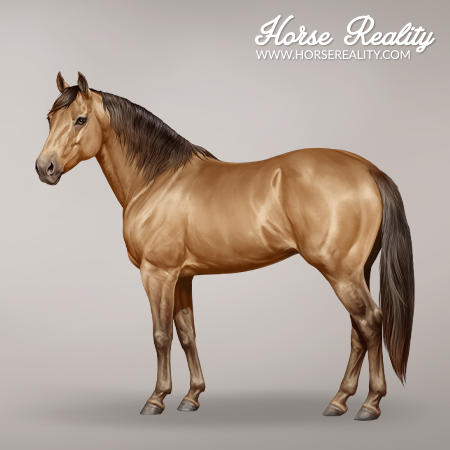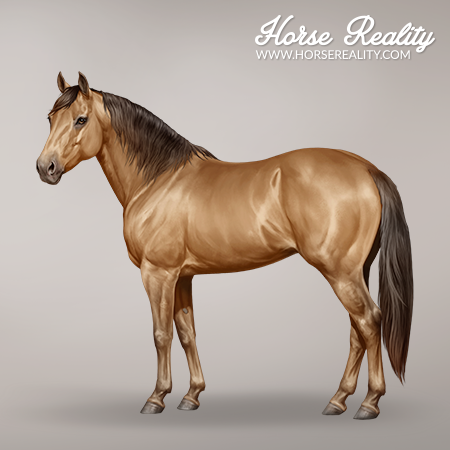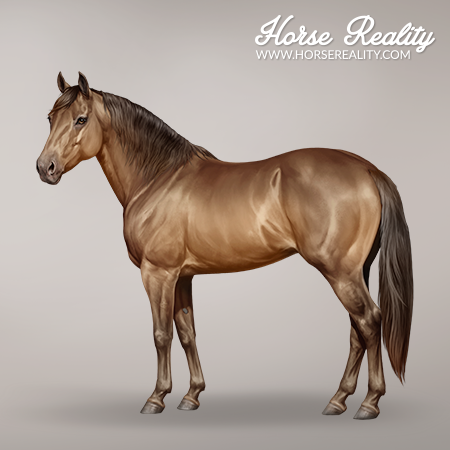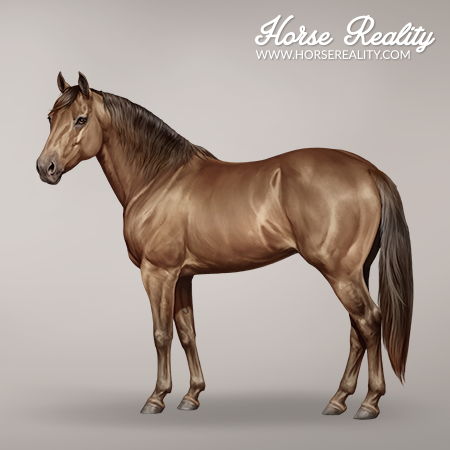Champagne is one of the dilutions present in horses.
¶ Phenotype
The champagne dilution affects both red and black pigment. Red hair becomes gold, while black hair is diluted to a more chocolate brown, sometimes described as the colour of a Weimaraner dog. Often, a bright iridescence gives the coat a beautiful metallic look. The colour champagne creates depends on the underlying base coat colour and other dilutions that may be present (ie: champagne + cream).
The skin colour of champagne horses ranges from pink to lavender. Champagne horses are frequently born darker than their adult colour will be. Foals are born with blue-green eyes that darken to amber or hazel as the horse ages. Another typical characteristic is freckled skin. These small freckles start appearing in abundance as the horses age. They are particularly noticeable around the eyes, muzzle, under the tail, udder, and sheath. They can also have a purple tone.
Champagne horses can in some cases look almost identical to homozygous pearl horses: both have freckles/mottled skin, amber eyes, pinkish skin, and their coat colours can look very similar. Therefore, gene testing is very important. The freckles of champagne horses can be distinguished from the mottled skin caused by leopard complex patterns in several ways: leopard complex skin is dark and the freckles are larger, often also accompanied by depigmented spots.
| Champagne - Quarter Horse | |
| Example | Information |

|
Gold champagne (chestnut + champagne) With chestnut-based horses, the red pigment is diluted to a golden yellow. Mane and tail are often lightened to nearly white, but they may also remain dark and keep the coat's shade. This colour is easily confused with palomino. The main difference is the skin colour, which is diluted to a freckled pink with gold champagne, whereas palominos keep dark grey skin. |

|
Amber champagne (bay + champagne) The red coat from a bay horse is diluted to a golden shade similar to that of gold champagne, but the mane, tail and legs keep the chocolate brown similar to that of classic champagne. The contrast between the legs and the body may be very small, to the point where the brown is virtually non-existent on the legs. Amber champagnes can be confused with buckskins, though the skin on a buckskin is grey, while an amber champagne's skin is diluted to lavender-pink with freckles. |
|

|
Wild amber champagne (wild bay + champagne) Similar to amber champagne (see above), wild amber champagne further restricts dark points to a horse's pasterns or fetlocks. Often, the points appear more muted in colour. |

|
Sable champagne (seal brown + champagne) The seal brown-based version of amber champagne is called sable champagne, and can visually be hard to distinguish from both amber and classic champagne. |

|
Classic champagne (black + champagne) When champagne dilutes a black horse, the skin colour becomes chocolate brown, with a tint of mauve, best described as the colour of a Weimaraner dog. The mane, tail and legs turn the colour of chocolate brown, though the legs may be slightly lighter than the mane and tail. The skin is lavender-pink with freckles. |
¶ Genotype
The champagne dilution (CH) is caused by a mutation of the SLC36A1 gene and is a dominant trait. Homozygous horses are nearly impossible to distinguish from heterozygous horses.
Below, the resulting phenotype of each genotype is listed:
- CH/CH or CH/ch = Champagne
- Gold champagne = e/e + CH/_
- Amber champagne = E/_ A/_ + CH/_
- Sable champagne = E/_ A/_ + CH/_
- Classic champagne = E/_ a/a + CH/_
- ch/ch = Not champagne
Champagne can be tested at the Laboratory.
¶ Breeds
The champagne dilution is a New World mutation that originated from North America and is therefore mainly found in American horse breeds. The following table lists all breeds that can currently have the champagne (CH) allele in-game:
| Breeds |
| Akhal-Teke Horse |
| Arabian Horse |
| Brabant Horse |
| Brumby Horse |
| Camargue Horse |
| Cleveland Bay |
| Exmoor Horse |
| Finnhorse |
| Fjord Horse |
| Friesian Horse |
| Haflinger Horse |
| Icelandic Horse |
| Irish Cob Horse |
| Kladruber Horse |
| Knabstrupper |
| Lipizzaner |
| Lusitano |
| Mongolian Horse |
| Mustang Horse |
| Namib Desert Horse |
| Noriker Horse |
| Norman Cob |
| Oldenburg Horse |
| Pantaneiro Horse |
| Pura Raza Española |
| Quarter Horse |
| Shetland Pony |
| Shire Horse |
| Suffolk Punch |
| Thoroughbred |
| Trakehner Horse |
| Welsh Pony |
¶ References
- Bellone R., Sponenberg D. P., Equine Color Genetics, 4th Edition, 2017, Wiley-Blackwell
- UC Davis Veterinary Medicine, https://vgl.ucdavis.edu/test/champagne; Access: November 2022
- Generatio Center for Animal Genetics; https://generatio.de/en/guidance/lexicon/champagne-dilution-factor-horse; Access: November 2022